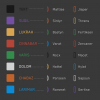There has been a lot of confusion about asteroid spawn chances and how it just works in general. Now that we fixed an oversight, it's time that we provide some crucial information.
Each asteroid type has its own assigned temperature. The biggest chance to find them, is in its temperature zone. There's a lot of deviation so it's entirely possible to find the coldest asteroid near a star although that chance will be very slim. Each time you visit an asteroid sector, it will check the temperature of where you're right now and then spawn X asteroids based on that.
Here you see our 8 asteroid types we use right now with its shards and ores next to it. It's arranged from hot to cold.

This is a simple example of where you'll find each asteroid. The zones demonstrate how far asteroids usually deviate (but there are exceptions).

And here we have a more detailed horizontal cross section of a system with its star in the middle. Each visualized asteroid belt is where you'll have the biggest chance finding that asteroid type.

Now, because the temperature decreases with distance, and our systems are a cubic shape, the coldest areas are actually in the corners so it's slightly different if asteroid belts are angled. The example below is at a 45° angle.

Thanks to schema for providing the needed information and thanks to kupu for visualizing the system!
EDIT: I want to point out that the shown numbers are from release 0.19538. The previous release had different asteroid temperatures, ranging from 0.9 to 0.1.
Each asteroid type has its own assigned temperature. The biggest chance to find them, is in its temperature zone. There's a lot of deviation so it's entirely possible to find the coldest asteroid near a star although that chance will be very slim. Each time you visit an asteroid sector, it will check the temperature of where you're right now and then spawn X asteroids based on that.
Here you see our 8 asteroid types we use right now with its shards and ores next to it. It's arranged from hot to cold.

This is a simple example of where you'll find each asteroid. The zones demonstrate how far asteroids usually deviate (but there are exceptions).

And here we have a more detailed horizontal cross section of a system with its star in the middle. Each visualized asteroid belt is where you'll have the biggest chance finding that asteroid type.

Now, because the temperature decreases with distance, and our systems are a cubic shape, the coldest areas are actually in the corners so it's slightly different if asteroid belts are angled. The example below is at a 45° angle.

Thanks to schema for providing the needed information and thanks to kupu for visualizing the system!
EDIT: I want to point out that the shown numbers are from release 0.19538. The previous release had different asteroid temperatures, ranging from 0.9 to 0.1.
Last edited:
